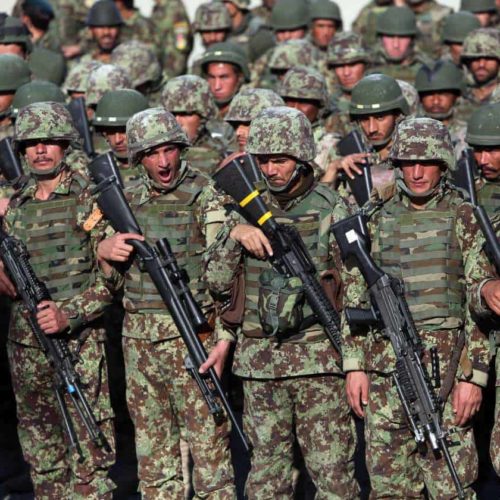The story was co-published with The Huffington Post.
Introduction
The U.S. government’s subsidies for Afghan security forces are allocated on a per capita basis, with the amounts reasonably pegged to the number of police and military personnel authorized to be on the rolls. But federal auditors have long worried that many personnel ostensibly in the forces are nothing more than ghost workers who don’t show up, leaving the extra funds in the hands of corrupt Afghan officials.
That’s why Defense Secretary Ashton Carter raised eyebrows when he announced a few weeks ago that the Pentagon intends to finance an Afghan security force through 2017 at its existing, authorized level of 352,000 personnel — a force more than 50 percent bigger than the NATO alliance earlier said it would support at the end of that period.
Federal auditors, in particular, are warning that this may be a hard ambition to fulfill, since no one has a solid estimate of how large that force is now, or a good way of finding out anytime soon.
Special Inspector General for Afghanistan Reconstruction John F. Sopko plans to testify before a House subcommittee on April 29, for example, about his enduring concern that “neither the United States nor its Afghan allies truly know how many Afghan soldiers and police are available for duty, or, by extension, the true nature of their operational capabilities.”
Layers of uncertainty undermine the reliability of existing troop strength data, according to Sopko’s testimony, which was obtained in advance by the Center for Public Integrity. The NATO-led military command in Afghanistan relies on the Afghan army and police to collect it with oversight from the Interior and Defense Ministries, he said. But the army and police often use inconsistent handwritten records instead of electronic systems, and the ministries’ efforts to verify it consist only of occasional, informal visits to army units.
That fundamental — but unreliable — data forms the basis for all U.S. financial assistance and training for the Afghan security forces, according to Sopko.
The uncertainties about the troop rolls have become particularly evident in recent months. In a supplement to a quarterly report issued in January, Sopko wrote that “just hours before” its release, the senior U.S. military commander in Afghanistan told him the numbers his agency received between April and October, 2014, were incorrect. The commander attributed the mistake to an “accounting” issue that overstated the total between 4 and 5 percent.
The size and strength of Afghan forces has been further obscured by the U.S. military’s recent decision to classify some of the data. Several months ago, for example, the NATO-led command in Afghanistan classified its assessments of Afghan national security forces’ fighting as well as the number of Afghan soldiers and police officers. That decision was partially reversed, after some embarrassing publicity, but attrition figures for the Afghan army at the corps level and below remain classified, as do the tallies of aircraft in the country’s inventory, according to Alex Bronstein-Moffly, a spokesman for Sopko.
Corps level data about Afghan security forces is not just classified — it is not reliably known, U.S. military officials have confirmed.
The NATO-led Resolute Support Mission’s composite commands “cannot adequately observe or verify” information at the Army corps level, U.S. Army Maj. Gen. Todd T. Semonite wrote in early April after Sopko recommended that the command implement stiffer controls over the daily attendance process for Afghan army personnel.
“It is easy to question why payroll systems and processes were not focused on earlier in this fight… Well, we were focused on saving American lives!!” Semonite added in a handwritten note beneath his official response.
The accounting error consisted of double counting civilians assigned to the Afghan army because they were listed twice in the strength counts that the U.S. forces received, wrote U.S. Forces-Afghanistan spokesman Col. Brian Tribus in emailed responses to questions from the Center for Public Integrity. Tribus noted that the strength reports from the Afghan army are translated from Dari and re-formatted before U.S. forces look at them.
The current force of U.S. and coalition soldiers on the ground is less than 4 percent the size of the Afghan defense security forces, so they lack the ability to “observe the entire accountability process” for the forces, according to Tribus.
Semonite said he agreed with Sopko’s recommendation that the Afghan Defense Ministry should use an electronic system to track and report Afghan army personnel and payroll data, but he called Sopko’s suggested deadline of January 2016 “not achievable” and recommended pushing it back by 15 months.
In 2012, leaders from Afghanistan and NATO member countries agreed at a summit in Chicago that the size of the Afghanistan National Security Forces should be 228,500 after the end of the NATO combat mission in 2014. They also said the Afghan government should begin contributing at least $500 million of the estimated $4.1 billion annual budget for those forces by 2015.
The higher force strength that Carter said he now wants will cost at least $1.4 billion extra each year, according to estimates the Defense Department provided to Sopko, as explained in a new quarterly report that he plans to release April 30.
In 2015, the Afghan government did indeed contribute half a billion to the Afghanistan Security Forces, according to the Defense Department’s fiscal year 2015 budget request for the forces. But the department’s budget request for 2016 projected spending by the Afghan government of only $250 million for its army and police.
Read more in National Security
Up in Arms
Nuclear weapons labs hit with sizable fines for new security violations
A classified material was missing for years before anyone noticed, and a lab official’s public slides included bomb design data
National Security
Former Energy Department official wins huge pay raise after moving to firm with deep ties to DOE
His new employer is seeking a $2 billion loan guarantee from his former employer, and he’s already chatting about the company with officials at a DOE lab


Join the conversation
Show Comments